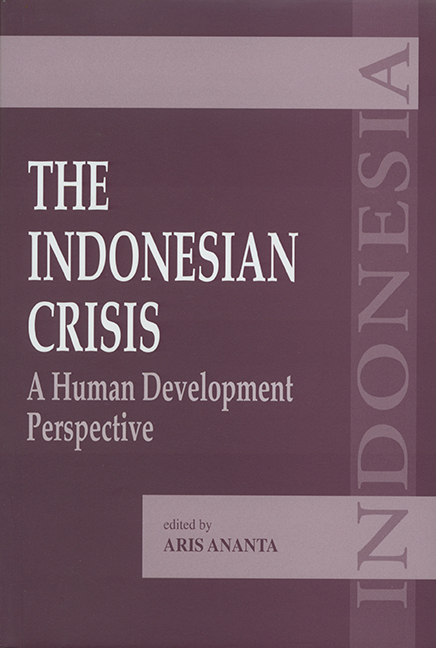Book contents
- Frontmatter
- Contents
- Acknowledgements
- List of Contributors
- Part I Introduction
- Part II Human Capital
- 5 Freedom from Fear: Social Disruption and System of Violence in Indonesia
- 6 Health Status of Indonesians During the Economic Crisis
- 7 The Indonesian Economic Crisis: Impacts on School Enrolment and Funding
- 8 Population Mobility and Social Conflict: The Aftermath of the Economic Crisis in Indonesia
- Part III Purchasing Power
- Part IV Emerging Issues
- Index
6 - Health Status of Indonesians During the Economic Crisis
from Part II - Human Capital
Published online by Cambridge University Press: 21 October 2015
- Frontmatter
- Contents
- Acknowledgements
- List of Contributors
- Part I Introduction
- Part II Human Capital
- 5 Freedom from Fear: Social Disruption and System of Violence in Indonesia
- 6 Health Status of Indonesians During the Economic Crisis
- 7 The Indonesian Economic Crisis: Impacts on School Enrolment and Funding
- 8 Population Mobility and Social Conflict: The Aftermath of the Economic Crisis in Indonesia
- Part III Purchasing Power
- Part IV Emerging Issues
- Index
Summary
Introduction
After two decades of sustained economic growth and rapid social development, as indicated by the reduction of poverty from 40 per cent to 11 per cent and the halving of the child mortality rate (GOI and UNICEF 2000, p. 1), Indonesia, in mid-1997, entered a period of sustained economic insecurity. Towards the end of 1997, the rupiah began to lose value. By January 1998, when the monthly inflation rate had reached 6.9 per cent, the Government of Indonesia officially stated that the country had been hit by a severe monetary crisis (Gardner and Amaliah 1999). Since then, inflation has soared. The value of the rupiah to the U.S. dollar had been dramatically falling from 2,470 in July 1997 to 15,000 in February 1998. During that period, the annual inflation rate was 34.2 per cent. Inflation continued to rise to reach 47 per cent in April 1998 and 59 per cent in July 1998. Only after early 1999, the rupiah began to stabilize at around 8,000 to the U.S. dollar. Nevertheless, its value against foreign currency continues to fluctuate.
The monetary crisis soon became an economic crisis, which ballooned into a full social crisis with wide-ranging effects on wages, employment, education, and health services. These, in turn, affected the people's health, particularly the vulnerable and the poor, including children and women. The crisis, among other things, caused the costs of basic commodities, health services, and school tuition fees to rise. It also seriously eroded the already limited resources of the government, the private sector, communities, and families.
The crisis has radically transformed the nature of state governance. Since the start of the crisis, the Soeharto government has crumbled and fallen, the interim government of Habibie has opened doors to democratization but failed to carry the nation through the portals, and the democratically elected government of Abdurahman Wahid has found itself beset by faction fighting and social conflict. Indonesia continues to experience a profound period of wide-ranging transition and great uncertainty. This has led to wider religious and ethnic conflicts in different regions of the country, posing a threat to survival, development, and protection of the vulnerable, especially children and women.
- Type
- Chapter
- Information
- The Indonesian CrisisA Human Development Perspective, pp. 159 - 181Publisher: ISEAS–Yusof Ishak InstitutePrint publication year: 2002



